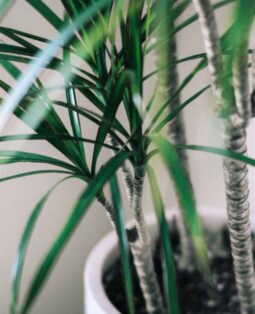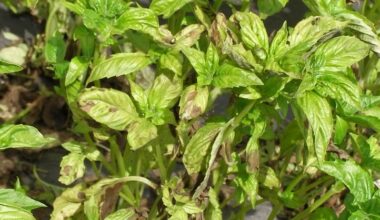The dragon tree is not a plant that requires a lot of attention when it comes to its maintenance, however, some mistakes can kill it fairly quickly. Here are 6 reasons for the death of a dragon tree:
- Air too dry
- Lack of watering
- Watering too often
- Contaminated soil
- Receive too much fertilizer
- Burned by excess chlorine
The Dracaena, also known as the Dragon Tree, appears externally as a palm. It evokes a tropical atmosphere in every home and is distinguished by an intense leaf green.
Contents
Why your dragon tree is dying
-
The air is too dry
This is a recurring problem in our homes in the winter. The air is too dry because it is heated, which reduces its relative humidity. The leaf loses more water through perspiration to compensate. In this case, not enough water reaches the tip of the leaf, as it is the part of the leaf furthest from the sap transport vessels. Since it receives less than its share of water, the tip tends to die.
Solution: Increase the humidity of the air by any means you choose.
-
The plant lacks water
If you don’t water enough at a time, or if you delay watering too long, the leaves will be stressed by a lack of water. And again, the tip, being further from the sap transport vessels, will scoop more.
Plants in hanging baskets are more prone to damage, not only because the foliage of these plants is more exposed to dry air and therefore dries out more, but these containers only have a small saucer that overflows easily, so they tend to be watered less than other plants so as not to cause damage, with the result that the plant constantly suffers from water stress, stress that appears especially on the tips of the leaves.
Solution: Water abundantly, enough to moisten the entire root ball, and repeat as soon as the soil is dry to the touch. If the soil is dry only 4 or 5 days after watering, it would be wise to repot in a larger pot. As for hanging baskets, rather than watering them sparingly, immerse them in water so that the potting soil can actually soak up the liquid.
-
The plant receives too much water
Strange as it may seem, as much as a lack of water can cause brown spikes, so can an excess of water. Indeed, when the soil is still soggy, the roots start to die*. But if the roots die, less water will reach the foliage… and it is always the tip of the leaf that will be hit first, causing it to die.
*Some rare houseplants prefer their roots to always soak in water, especially the house papyrus (Cyperus alternifolius). For these plants, an excess of water is never to be feared.
Solution: Learn to apply the golden rule of watering: always wait until the soil is dry before watering again. To find out, push a finger into the potting soil until the second joint. If you’re worried that too much water has killed the roots of your plant, however, it’s more serious. Remove the plant, cut off the rotten roots, repot… and cross your fingers. When a plant’s root system is heavily invested with rot, it is not always possible to save it.

-
The soil is contaminated
Over time, mineral salts from hard water and fertilizers accumulate in the soil of houseplants and gradually poison it, killing some of the roots. If the roots die partly, the leaves will also die partly because they will no longer receive their full share of water.
Again, the tip will scoop more. Also, its salts tend to accumulate in the tip of the leaves, making the problem worse.
Solution: Launder the potting soil of your houseplants at least 2-3 times a year or put them outside in the summer to be washed by the rain. And repot regularly, changing the potting soil at the same time.
-
The plant receives too much fertilizer
If you tend to fertilize a lot, you create a situation similar to a soil contaminated with mineral salts: the excess minerals tend to go up into the leaves and concentrate in the tip.
Solution: Fertilize your plants, all right, but never over-fertilize. The usual rule of thumb for houseplants is to apply fertilizer at a quarter of the indicated rate and only during the growing season.
-
The foliage is burned by excess chlorine.
Some plants, such as dragon tree, cordylines and spider plants, are very prone to chlorine build-up in the soil. However, if your water comes from a municipality, it probably contains chlorine.
Solution: Use water that has not had chlorine added to it: rainwater, distilled water, spring water, etc. Note that the idea that letting the irrigation water sit for 24 hours to evaporate the chlorine is a myth. The type of chlorine commonly used, chloramine, does not evaporate.
Attacks and diseases of the dragon tree
Few parasites attack the dragon tree, but aphids and scale insects can arrive if the atmosphere is too dry. In this case, remove the pests with a damp cloth or one soaked in modified alcohol and spray the foliage more regularly.
Yellowing leaves indicate the presence of red spiders in too dry an atmosphere as well.
Collapsing leaves, or grey spots on the foliage, however, are a sign of pathogenic fungal attack or even root or crown rot. The plant is over-watered or residual water is not removed, which suffocates the soil and roots. This can be recuperated by letting the root ball dry and then changing the potting soil.
Finally, if the leaves fall off for no apparent reason, the plant is cold. Turn up the heating.

Maintenance of the dragon tree
Watering the dragon tree
Water your dragon tree every week: the substrate must remain moist without stagnant water. Empty the saucer under the pot, or the pot cover if it is not perforated. Let the surface dry very slightly before watering again: the soil must not be soggy.
In spring and summer, water your plant once a month.
In winter, let the soil dry a little more.
If the atmosphere in your room is dry, spray the foliage daily and place the pot on a bed of damp logs or pebbles. For more information, read our tips on caring for green plants in winter.
Dragon Tree Fertilizer
Fertilize your plant every 15 days during the growing period. Use a special indoor plant fertilizer.
Repotting of the dragon tree
Only repot your dragon tree when the roots come out of the pot because they like to feel cramped. The dragon tree draco is an exception. In his case, take a larger pot because he likes to have space.
Summary
In most cases, the death of a dragon tree comes from: watering, soil, or exposure, these are the 3 main reasons.
More rarely, it happens that the dragon tree is attacked. We explain everything in this article to overcome these problems.









